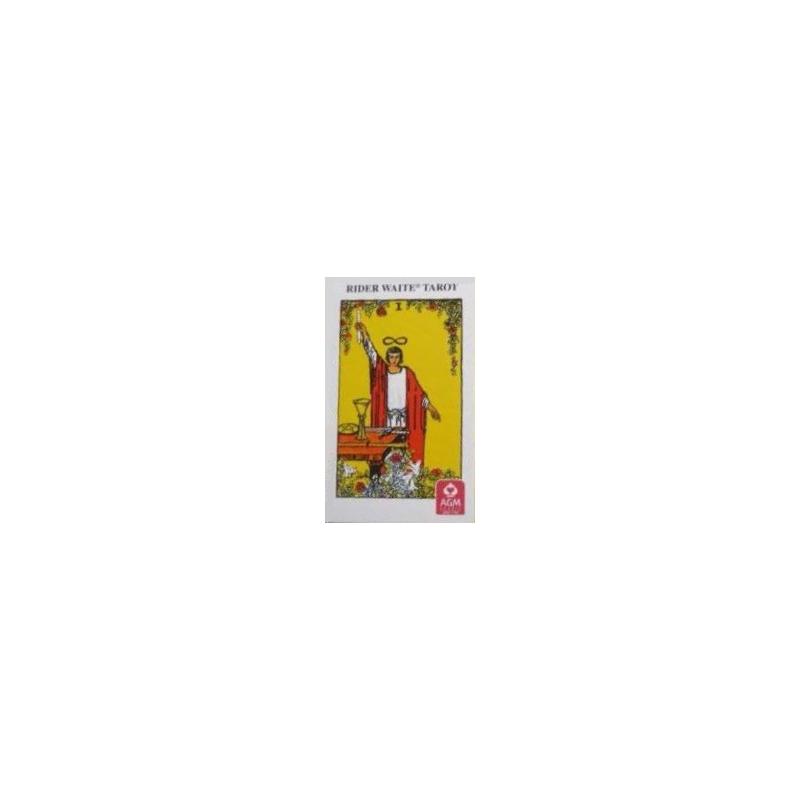Cod.Bar. Alternativos: 1067012386
Las cartas fueron dibujadas en 1909 por Pamela Colman Smith bajo la dirección de Arthur Edward Waite. Los vibrantes dibujos de Smith transformaron la baraja del tarot estándar.
"Una característica única de la baraja de Rider-Waite, y una de las principales razones de su popularidad duradera, es que todas las cartas, incluyendo los Arcanos Menores, muestran escenas llenas con figuras y símbolos. Antes del Tarot Rider-Waite, las actuales cartas numeradas de casi todas las barajas de tarot estaban solamente marcadas con los signos de los palos - espadas, bastos, copas y oros, o pentáculos. Las imágenes pictóricas en todas las cartas permiten interpretaciones sin la necesidad de consultar repetidamente un texto explicativo al respecto. Los innovados Arcanos Menores, y la habilidad de Pamela Colman Smith para captar las sutilezas de emoción y experiencia, han hecho del Tarot Rider-Waite un modelo para los diseños de muchos paquetes de tarot”. - (De La Enciclopedia de Tarot, Tomo III)
El Tarot Rider-Waite fue nombrado uno de los diez mejores Tarot de todos los tiempos por Aeclectic Tarot.
Pamela Colman Smith
Nace el 16 de febrero de 1878, en Middlesex, Inglaterra; siendo hija de padres estadounidenses. Su infancia de transcurrió entre Londres, Nueva York y Kingston, Jamaica. Durante su adolescencia, viajó a través de Inglaterra con la compañía de teatro de Ellen Terry y Henry Irving. Luego, comenzó sus estudios formales en arte en el Instituto Pratt de Brooklyn, graduándose en 1897.
Smith regresó a Inglaterra, donde se convirtió en diseñadora de escenarios para el teatro en miniatura, y en ilustradora - principalmente de libros, folletos y carteles. Alrededor de 1903, se unió a la Orden Hermética de la Aurora Dorada. En 1909, bajo la guía de Arthur Edward Waite, realizó una serie de setenta y ocho pinturas alegóricas descritas por Waite como un paquete de tarot rectificado. Los diseños, publicados en el mismo año por William Rider & Son, son ejemplos del misticismo, ritual, imaginación, fantasía y profundas emociones de la artista.
Arthur Edward Waite
Nacido en Estados Unidos en 1857, Waite fue criado y educado como católico en Inglaterra. Comenzando sus 21 años, Waite persigue, investiga y escribe sobre asuntos psíquicos y esotéricos. Poco después de entrar en la Orden Hermética de la Aurora Dorada, se convirtió en el Gran Maestro, y redirigió el sentido de la orden de la magia al misticismo. La Orden Dorada, cuya estructura jerárquica se basó en la Cábala, es considerada la mayor influencia del siglo XX en el ocultismo. Waite fue un prolífico autor de textos ocultistas, orientados al Santo Grial y al conocimiento místico, lo cual comprendió la base de Tarot moderno. Waite es mejor conocido como el co-creador del Tarot Rider-Waite y autor de su volumen acompañante “La clave pictórica al Tarot” (The Pictorial Key to the Tarot), publicado por primera vez en 1910.
The cards were drawn in 1909 by Pamela Colman Smith under the direction of Arthur Edward Waite. Smith's vibrant drawings transformed the standard tarot deck.
"A unique feature of the Rider-Waite deck, and one of the main reasons for its enduring popularity, is that all the cards, including the Minor Arcana, show scenes filled with figures and symbols. Before the Rider-Waite Tarot, the The current numbered cards of almost all tarot decks were only marked with the signs of the suits - swords, wands, cups and pentacles, or pentacles. The pictorial images on all cards allow interpretations without the need to repeatedly consult an explanatory text at the time. respect. The innovative Minor Arcana, and Pamela Colman Smith's ability to capture the subtleties of emotion and experience, have made the Rider-Waite Tarot a model for the designs of many tarot packs." - (From The Encyclopedia of Tarot, Volume III)
The Rider-Waite Tarot was named one of the top ten Tarots of all time by Aeclectic Tarot.
Pamela Colman Smith
Born on February 16, 1878, in Middlesex, England; being the daughter of American parents. His childhood was spent between London, New York and Kingston, Jamaica. During his teenage years, he traveled throughout England with the theater company of Ellen Terry and Henry Irving. He then began his formal studies in art at the Pratt Institute in Brooklyn, graduating in 1897.
Smith returned to England, where she became a set designer for the miniature theatre, and an illustrator - mainly of books, pamphlets and posters. Around 1903, he joined the Hermetic Order of the Golden Dawn. In 1909, under the guidance of Arthur Edward Waite, he made a series of seventy-eight allegorical paintings described by Waite as a rectified tarot packet. The designs, published in the same year by William Rider & Son, are examples of the artist's mysticism, ritual, imagination, fantasy and deep emotions.
Arthur Edward Waite
Born in America in 1857, Waite was raised and educated as a Catholic in England. Beginning his 21st year, Waite pursues, researches and writes about psychic and esoteric matters. Shortly after entering the Hermetic Order of the Golden Dawn, he became Grand Master, and redirected the order's meaning from magic to mysticism. The Golden Order, whose hierarchical structure was based on Kabbalah, is considered the greatest influence of the 20th century on occultism. Waite was a prolific author of occult texts, oriented to the Holy Grail and mystical knowledge, which formed the basis of modern Tarot. Waite is best known as the co-creator of the Rider-Waite Tarot and author of its companion volume The Pictorial Key to the Tarot, first published in 1910.





